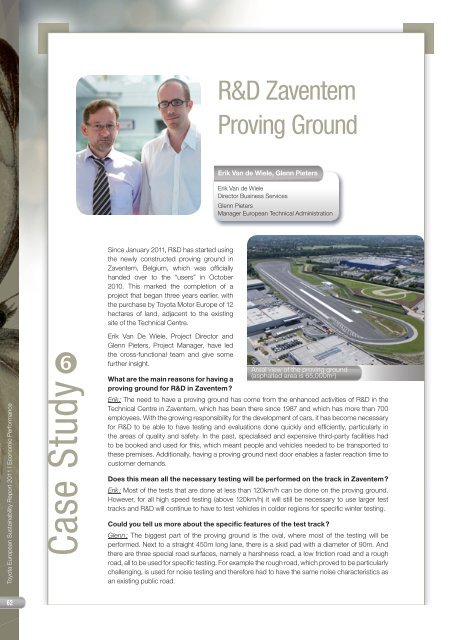Toyota Environmental Sustainablity Report
Toyota Environmental Sustainablity Report
Toyota Environmental Sustainablity Report
Create successful ePaper yourself
Turn your PDF publications into a flip-book with our unique Google optimized e-Paper software.
<strong>Toyota</strong> European Sustainability <strong>Report</strong> 2011 I Economic Performance<br />
62<br />
<br />
Case Study<br />
Since January 2011, R&D has started using<br />
the newly constructed proving ground in<br />
Zaventem, Belgium, which was offi cially<br />
handed over to the “users” in October<br />
2010. This marked the completion of a<br />
project that began three years earlier, with<br />
the purchase by <strong>Toyota</strong> Motor Europe of 12<br />
hectares of land, adjacent to the existing<br />
site of the Technical Centre.<br />
Erik Van De Wiele, Project Director and<br />
Glenn Pieters, Project Manager, have led<br />
the cross-functional team and give some<br />
further insight.<br />
What are the main reasons for having a<br />
proving ground for R&D in Zaventem ?<br />
R&D Zaventem<br />
Proving Ground<br />
Erik Van de Wiele, Glenn Pieters<br />
Erik Van de Wiele<br />
Director Business Services<br />
Glenn Pieters<br />
Manager European Technical Administration<br />
Areal view of the proving ground<br />
(asphalted area is 65,000m 2 )<br />
Erik : The need to have a proving ground has come from the enhanced activities of R&D in the<br />
Technical Centre in Zaventem, which has been there since 1987 and which has more than 700<br />
employees. With the growing responsibility for the development of cars, it has become necessary<br />
for R&D to be able to have testing and evaluations done quickly and effi ciently, particularly in<br />
the areas of quality and safety. In the past, specialised and expensive third-party facilities had<br />
to be booked and used for this, which meant people and vehicles needed to be transported to<br />
these premises. Additionally, having a proving ground next door enables a faster reaction time to<br />
customer demands.<br />
Does this mean all the necessary testing will be performed on the track in Zaventem ?<br />
Erik : Most of the tests that are done at less than 120km/h can be done on the proving ground.<br />
However, for all high speed testing (above 120km/h) it will still be necessary to use larger test<br />
tracks and R&D will continue to have to test vehicles in colder regions for specifi c winter testing.<br />
Could you tell us more about the specifi c features of the test track ?<br />
Glenn : The biggest part of the proving ground is the oval, where most of the testing will be<br />
performed. Next to a straight 450m long lane, there is a skid pad with a diameter of 90m. And<br />
there are three special road surfaces, namely a harshness road, a low friction road and a rough<br />
road, all to be used for specifi c testing. For example the rough road, which proved to be particularly<br />
challenging, is used for noise testing and therefore had to have the same noise characteristics as<br />
an existing public road.

















